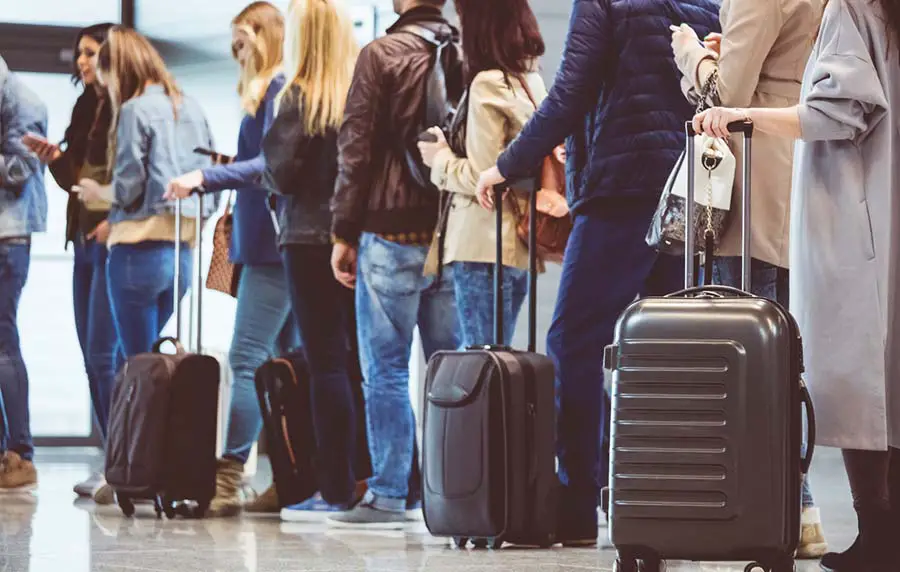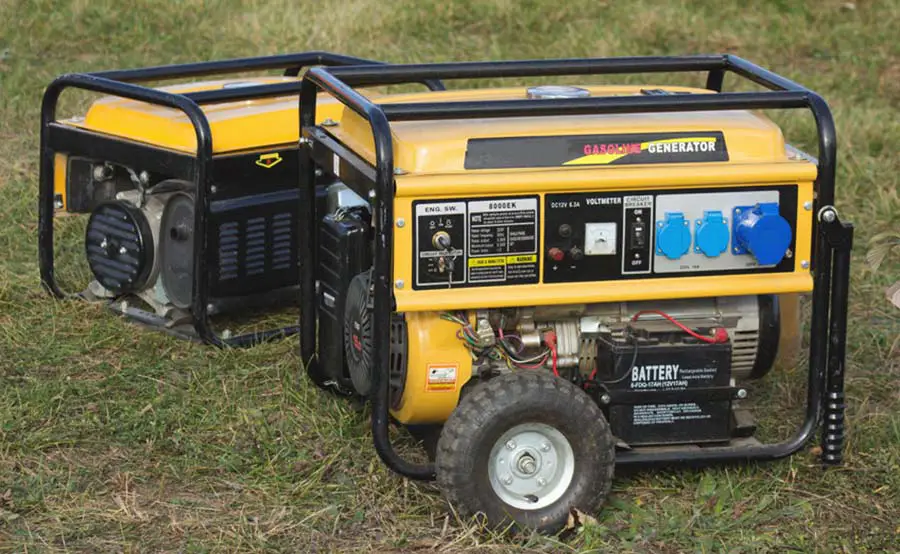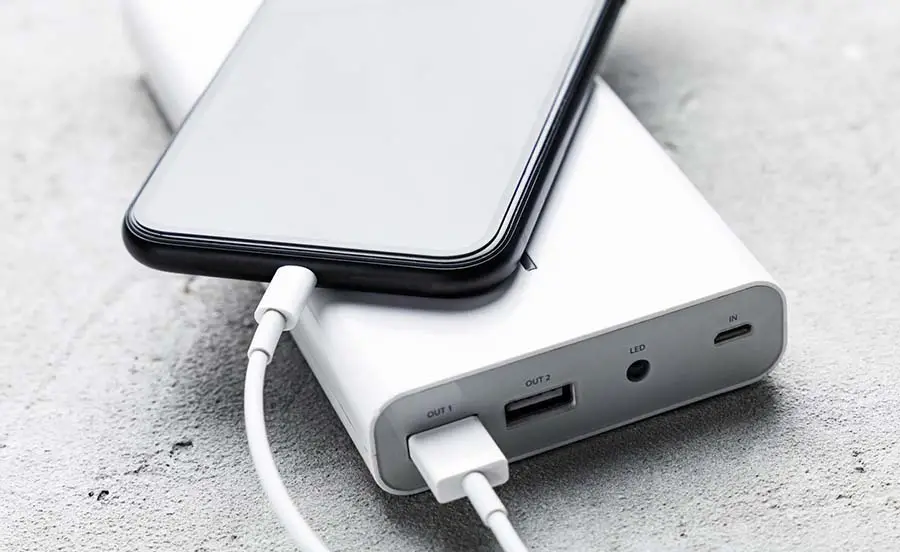
A portable generator is very versatile in use, and its portability means that you can move it from one place to another. But what if you want to transport the generator overseas or over a long distance that requires a plane trip. Can you take the generator on a plane?
The U.S. Transport Security Administration (TSA) states that you cannot take any engine-powered equipment on a plane as a carry-on or checked baggage. Some airlines may allow a generator that has been completely purged of all fuel and residual vapors. Some airlines may refuse to allow engine-powered equipment in checked baggage if it has previously contained gasoline, even if the fuel is completely removed.
There are several considerations regarding portable generators and other power sources when taking them on a plan with you. Let’s take a closer look.
Can You Bring a Portable Generator On a Plane?

Under no circumstances can you bring a generator, or any power equipment for that matter, that has fuel or residual fuel on a plane. This rule applies to all airlines and both carry-on and checked luggage.
To travel with a portable generator, you must drain all of the oil and fuel from the machine. Make sure you empty any residual fuel or vapors as well. However, you should check with the airline first. Some airlines have a strict policy of no power equipment, including generators.
The TSA also warns that some air companies may refuse to carry a portable generator if there has ever been fuel in it. Hence in some cases, you must have a brand new, unused portable generator if you intend to transport it on a plane.
The FAA (Federal Aviation Administration) prohibits all hazardous materials from being taken onto commercial flights because of the risk they pose to the safety of everyone on board and their aircraft.
This includes lithium-ion batteries that power everything from cell phones to laptops and liquid oxygen tanks that some patients rely on for breathing.
There are safer ways of getting portable power when you need it.
Many retailers sell compact, lightweight inverters with jump-starter options that are small enough to fit in a suitcase or carry-on bag and work with your car’s battery to produce AC power with the simple flip of a switch. These inverters can provide several hours’ worth of emergency power for vital pieces of equipment like medical devices or refrigerators that are safe to run inside your home. In contrast, they’re being powered by an external source.
A different solution that won’t require bringing hazardous materials on board is purchasing an electric generator designed specifically for outdoor use.
Can I Take A Power Inverter on a Plane?
Power inverters are devices that allow you to plug-in appliances that require electricity into your car’s power outlet. Generators aren’t generally used as an alternative source of power for onboard devices because they can be too loud and are not allowed by airlines.
Airline Baggage Guide Airlines have restrictions about what items passengers can bring through security checkpoints, whether flying or checking the bags. The usual items such as firearms, knives and other weapons, sports equipment such as baseball bats or golf clubs are prohibited in carry-on and checked baggage.
Deciding which item is allowed versus the item that’s prohibited goes back to whether or not it can fit in the overhead bin or under your seat. The airport authority reserves the right to inspect any bag you bring onboard an aircraft.
The TSA limits the number of batteries allowed for each passenger flight; no more than two spare batteries are allowed per passenger.
Electrical power tools are acceptable for carry-on baggage if the batteries are removed and packed following the current regulations (i.e., fully encased in a manner that will not activate the device).
You cannot take portable generators on commercial aircraft; they must be transported by ground transportation. People living in remote or rural areas may pose an inconvenience when attempting to travel to airports because their home is not connected to public transit (some airports do offer shuttle services). The generator can be delivered overnight, online, or via express courier service.
The TSA states that only one replacement battery is allowed per person; however, many airlines allow you to bring up to two spare batteries per person provided the battery terminals are completely covered by insulating material designed to protect the terminals.
The TSA states that each passenger is only allowed two spare batteries in carry-on bags, but many airlines allow more than two depending on where you are flying to. It would be best to contact the airline regarding their specific policies regarding batteries before arriving at the airport.
You can’t check battery-powered devices for safety reasons. The FAA prohibits passengers from checking any flammable items; this includes all batteries (except hearing aid and electric shaver). The FAA also prohibits the shipping of flammable liquids, including gasoline, whether it’s full or empty.
Can You Bring a Power Bank on a Plane?
We have earlier elaborated that there are limited chances that you’ll be allowed to carry your portable generator on the plane, especially when there’s fuel in it. You may, as a result, be wondering whether you can alternatively carry your power bank during flight to take care of your power needs.
You can bring your power bank on a plane, but you must ensure that it meets the critical prerequisites of the regulatory agencies. Also, you must ensure that you carry the battery bank as carry-on luggage.
Power banks are a form of battery made from lithium-ion. Hence, there is a chance that they can be hazardous when carried during flight. They are also flammable, and thus if not regulated, they can cause a plane explosion.
Due to the above reasons, airport personnel will ask you to remove your power bank if you store it as checked-in luggage. Also, you must ensure that it meets the required safety guidelines. Otherwise, you will be required to leave it during the flight.
Why are Lithium-Ion Batteries Considered Safety Hazards?
Lithium-ion batteries are components of some of the most common portable electronic devices such as laptops and cellphones. Therefore, you may not think of them as safety hazards. However, they are potentially dangerous, and you must handle them with care, especially during flights.
The Occupational Safety and Health Administration (OSHA) regards Lithium-ion batteries as safe. However, they pose safety hazards as they are likely to explode, especially if handled inappropriately.
In addition to the risk of exploding, they can also lead to chemical burns. Additionally, they can also explode if not well handled. Therefore, you should take special care when handling and storing the batteries.
What Are the Power Bank Regulations On Planes?
The FAA recommends a maximum power bank capacity of 100 Wh during flight. The International Air Transport Association (IATA) regulations allow for a higher capacity of a maximum of 160Wh. Most airlines in the world are under the latter body. Hence the rule will be applicable for almost all the planes.
Therefore, the allowable power bank range is between 100 Wh and 160Wh. If you have a power bank rating above 160Wh, you will have to leave it at the airport. Hence it’s best not to carry it as there is a limited chance you will be allowed to board the plane.
However, there is no cause for alarm as most power banks have a maximum of 100Wh. The power is sufficient to charge most small devices like your phone and laptop.
Can I Bring a 20000mAh Power Bank on Plane?
You can carry a 20000mAH power bank on a plane without worrying that you’ll exceed the regulatory limits. Often you will find that you cannot find the battery bank’s rating in Watts per Hour (Wh). Therefore, you will have to do some conversions to see if your 20000mAH is within the stipulated limits.
20000mAH means that the power bank has a capacity of 20AH. Hence, to convert this to Wh, you need to multiply the rating by the voltage rating of the battery. In most batteries, it will be 3.7V. Thus, the battery capacity = 20 AH X 3.7V = 74 Wh.
Remember that the maximum FAA rating is 100Wh. Hence 74Wh is within the required limits and thus is safe to carry during flight.
You must take good care of your power bank and ensure the power rating is visible. If the power rating scrapes off, you will have difficulty explaining to the airline authorities that it is within limits. The scrutiny will be more intense if you are traveling internationally. Be as transparent as possible to save time when traveling by plane.
How many Power Banks Per Person are Allowed During Flight?
You can carry up to two power banks, each with a rating of 100Wh. It is still possible to travel with a power bank with a 160 Wh rating and another with 100Wh. However, you will need to ask the airline if they allow it. Prior notice is required if you have such power banks approximately 72 hours before your scheduled flight date.
However, it would be almost impossible if you want to ferry power banks with a rating beyond 160Wh. You may still get permitted by some airlines, but most do not allow it as it is beyond the IATA limits. Ideally, such a rating is dangerous in case it develops a problem.
Nonetheless, such power banks are rare. Thus, you do not have to worry that yours could be that size if you haven’t checked yet.
Also, note that you have to carry your power banks in your carry-on only. We earlier said that a power bank is a battery. Thus, there is a need to handle it with utmost care. At no time should it be in the checked-in luggage. You will be required to remove it if you put it in that luggage.
Some airlines may even confiscate it as it is considered dangerous. Hence, to be on the safe side, follow the regulations.
Best Power Banks to Take With You On a Plane

The following are some of the top power bank models you can carry when going on a long flight.
Zendure Power Bank, SuperTank 27,000mAh External Battery
The battery has a power capacity of 27,000mAh. It contains sufficient energy to provide power to a Macbook 8 Pro and other devices. The power bank will also supply power energy to USB C devices.
Another fundamental upside of the battery is that it will charge within 2 hours. Also noteworthy is that it is possible to charge the battery while also providing power to other external devices.
We recommend the power since it falls within the allowable limits of flight. The power capacity will also be enough to power devices up to 100W.
Anker PowerCore+ 26800 PD with 30W Power Delivery Charger
The model is one of the best concerning fast charging. It features a USB-C port that delivers 30W and two other USB ports. It has a capacity of 26800mAh, sufficient to give power to up to 7 cell phones and laptops.
The recharge time of the power bank is almost three times faster than the average power bank. Its power capacity is also within the recommended confines of use on a plane. Also, it will be enough to keep your devices charged.
PD Pioneer 26800mAh
The model is a USB PD Portable Charger capable of delivering 30W. It has a 26800mAh power capacity, which is within the requirements for most airlines. You can recharge it faster than the standard power bank.
With a port C output, the power bank will sufficiently power your MacBook and other devices that you’ll most have with you while flying, such as cellphones. The power bank also features iSmart 2.0 Technology, which facilitates fast charging of devices.
PD Pioneer 20000mAh 80W AC Portable Laptop Charger
The power bank is ideal for providing power for your laptop during a flight. It has a 20000mAh capacity, which is within the requirements of most airlines. In addition to charging your laptop, it will also provide sufficient power to run other devices such as your camera battery and cell phone.
Final Thoughts
In a nutshell, most airlines will not allow you to take a portable generator with you during a flight, especially if it has fuel traces. Many will still be skeptical about allowing you to carry a portable generator even if it does not have fuel.
Also, while you cannot transport liquid oxygen, you can travel with a portable oxygen concentrator. We have highlighted the essential procedures you need to undergo to transport the device.
Lastly, you can carry a power bank on a flight if it meets the minimum requirements. The FAA allowed maximum limit is 100Wh. However, IATA allows higher power limits of up to 160Wh. We have also listed some top-notch power banks that you can consider carrying when trailing on a plane.
Remember to check with your airline to travel with the above-discussed devices and other electronics.

